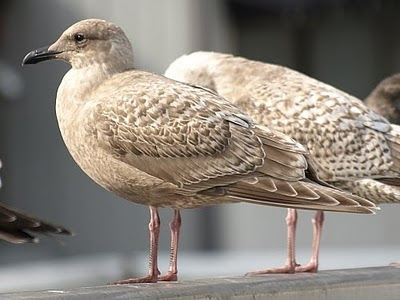



Mealy Redpolls at Wajima





 Male Siberian Snow Bunting P.n. vlasowae at Wajima
Male Siberian Snow Bunting P.n. vlasowae at WajimaBrazil (1991) only lists the form vlasowae for Japan and this fresh male's appearance with its cream-white fringes of its upperparts, much white showing through on the rump, restricted pale rusty breast-sides, no black on its lower back, rump and all but its longest uppertail-coverts, all conforms to the description of vlasowae included in BWP (1994). Whilst the RIACT Report (2006) acknowledges this form has occasionally been suspected in Britain it states that diagnosis is extremely problematic, owing to variations within other taxa. Indeed, BWP warns of part of the population of nivalis breeding in Canada, north-east Greenland, and Spitsbergen being similar to vlasowae and likely accounting for vlasowae-like birds recorded in Norway, Denmark, Netherlands, and perhaps Britain. That said, an alternative explanation is that vlasowae could be occuring as a vagrant alongside isulae and the more-similar nivalis during winter in Britain (and elsewhere in Europe) and among the British Museum's collection is a male BM (NH) 86.12.20.16 obtained in Berkshire in November 1874 considered probably of this form (Banks et al 1991).

Hegura-jima ferry entering Wajima Harbour









First-winter Black-tailed Gull at Wajima Harbour


Adult winter Black-tailed Gulls at Wajima Harbour












Juvenile Kamchatka Gulls L.(c.) kamtschatschensis at Wajima Harbour
A selection of mainly rather smooth-looking ashy-headed juveniles. Note the variation in bill colour. Some show strongly bicoloured bills whereas others are much darker. Most retain virtually their entire juvenile scapulars. Also note the sometimes rather coarsely barred rump.








Juvenile Kamchatka Gulls L.(c.) kamtschatschensis at Wajima Harbour
A selection of the beautifully white-headed juveniles that always seem to combine their white heads with strongly bicoloured bills and darker and more heavily-blotched (and therefore less smooth-looking) underparts and strikingly-patterned underwings.



 First-winter Kamchatka Gulls at Wajima Harbour
First-winter Kamchatka Gulls at Wajima HarbourA few far more advanced first-winter plumaged individuals were present sporting their virtually completely renewed blue-grey scapular and mantle feathers. Note the broad dark barring to the undertail-coverts.






Juvenile/first-winter Vega Gulls L. vegae at Wajima Harbour
A selection of typical-looking juvenile/first-winter Vega Gulls.

Juvenile Vega Gull in Wajima Harbour
A far more coarsely-marked and darker individual - perhaps a fresher juvenile?

 First-winter Gull sp. at Wajima Harbour
First-winter Gull sp. at Wajima Harbour Structurally this individual appeared close to Vega Gull but is it too pale? Can even an advanced Thayer's Gull be safely eliminated? That said, its plumage would appear far too advanced as Thayer's typically retains its juvenile plumage well into winter and its wavy tail pattern is very disconcerting all of which probably points to a hybrid. For an advanced (March) Thayer's Gull in Japan see:http://www23.tok2.com/home/jgull/06thay1w/thayers.htm




Juvenile Slaty-backed Gulls L. schistisagus at Wajima Harbour
A nice and straightforward selection of 'Bonxie-like' juvenile Slaty-backed Gulls.

Juvenile/First-winter Slaty-backed Gull L. schistisagus at Wajima Harbour
There are also plenty of seemingly pale juvenile/first-winter Slaty-backed Gulls also present. Note the primaries and tail band appear far too dark for Glaucous-winged Gull to be considered a possibility. See:




First-winter Slaty-backed Gulls L. schistisagus at Wajima Harbour
A selection of first-winter Slaty-backed Gulls showing the variation in between the darkest and palest present.











Second-winter Slaty-backed Gulls L. schistisagus at Wajima Harbour




Whilst closely resembling a first-winter Glaucous-winged Gull L. glaucescens, and as there seems so much to learn perhaps it is one, it's perhaps slightly weak-billed, its tail feathers are clearly not wholly dark and its rump appears too strongly patterned, probably rendering it a hybrid.





First-winter presumed hybrid Gull sp. at Wajima Harbour
This would appear a much more clear-cut hybrid. Its headshape certainly reminds me of a Glaucous-winged Gull L. glaucescens, so whilst I've not seen it documented, Vega x Glaucous-winged Gull would be my guess.
Whilst its primary pattern might suggest Thayer's Gull L. thayeri its structure, tertials and scapulars all suggest it's a very pale juvenile Vega Gull albeit with very weakly patterned greater coverts.
Even more reminiscent of Thayer's Gull L. thayeri, and possibly it is one, buts the patterning of its scapulars looks at odds with a 'safe' identification and the majority of its greater coverts too plain.
Another Gull resembling a Thayer's Gull L. thayeri but showing a strikingly contrasting white ground-colour to its rump, a curiously patterned tail and appearing rather strong-billed so all less than perfect features.
Another Gull not immediately possible to pigeonhole with any certaintly - at least, not by me! This one perhaps looks a little closer to Thayer's Gull L. thayeri with regard to its scapulars, coverts and rump but its tail pattern is again clearly not reassuringly wholly dark! Perhaps being geographically close to the west coast of the US it's no surprise that Japan's Gulls appear to comprise a similar 'melting pot' of hybrid combinations.
Species noted:
Cormorant 20
Grey Heron 3
Mallard 6
Spot-billed Duck 5
Pintail 2
Scaup 5
Black-eared Kite 50
Black-headed Gull 10
Black-tailed Gull 250
Kamchatka Gull 5
Vega Gull 25
Slaty-backed Gull 20
Siberian Buff-bellied Pipit 4
Black-backed Wagtail 3
Japanese Wagtail 3
Brown-eared Bulbul 100
Daurian Redstart 1
Blue Rock Thrush 3
Dusky Thrush 3
Carrion Crow 5
Large-billed Crow 10
Oriental Greenfinch 20
Mealy Redpoll 15
Snow Bunting 1













 Juvenile / first-winter presumed hybrid Gull sp. at Wajima Harbour
Juvenile / first-winter presumed hybrid Gull sp. at Wajima Harbour
 Juvenile / first-winter presumed hybrid Gull sp. at Wajima Harbour
Juvenile / first-winter presumed hybrid Gull sp. at Wajima Harbour














